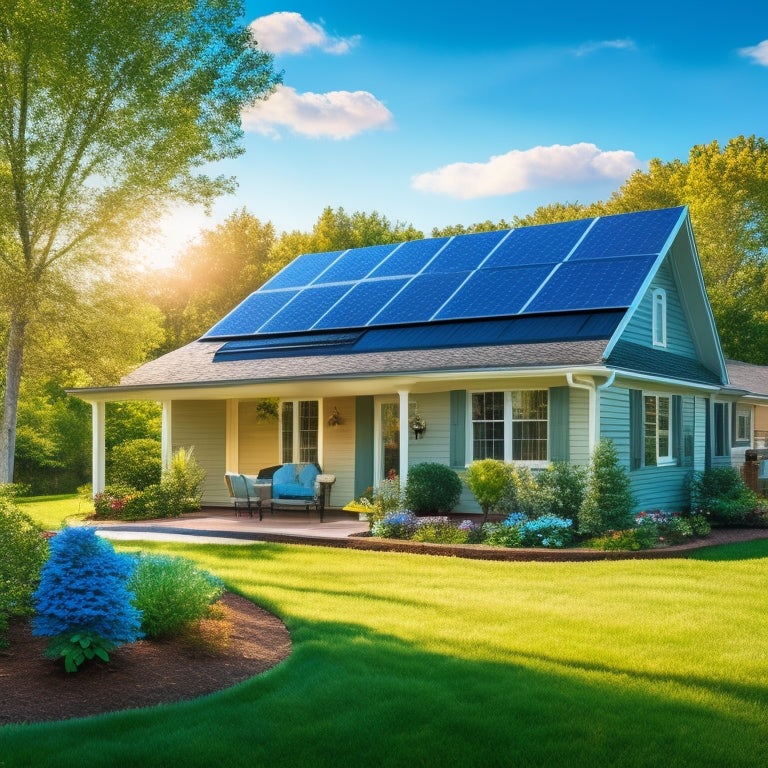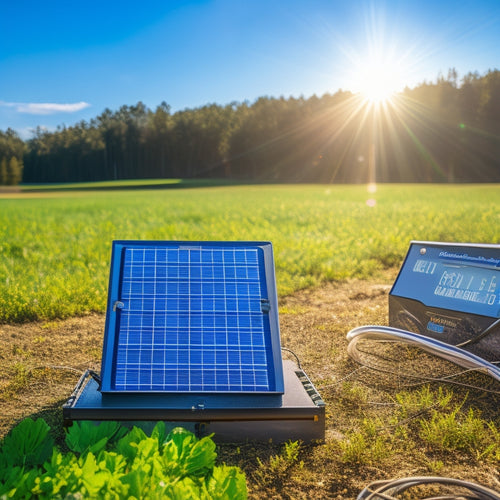
What's the Cost of Home Renewable Energy?
Share
You're likely looking at an upfront investment of between $12,500 to $35,000 or more for a standard residential solar panel system, before factoring in government incentives or rebates, which can greatly reduce the cost. This total cost includes equipment, installation, permits, and inspections, with system size, type, and installation complexity influencing the final amount. Battery storage systems and inverters add to the overall expense, but it's crucial to reflect on long-term benefits, such as energy independence and reduced consumption, when making your decision. As you manage the costs and components, you'll find that a clear understanding of your renewable energy system's potential awaits.
Overview
- The total cost of a renewable energy system includes equipment, installation, permits, and inspections, with solar battery storage systems ranging from $5,000 to $15,000 or more.
- Average solar panel costs vary based on equipment type, quality, installation company, and location, with typical residential system costs ranging from $12,500 to $35,000 before incentives.
- Inverter and installation fees are significant components of renewable energy system costs, with standard string inverter and installation costs averaging between $2,000 and $5,000.
- Battery storage prices depend on lifespan, charging efficiency, and maintenance costs, but government rebates and installation incentives can help offset expenses.
- System size, type, and installation complexity significantly influence overall costs, and government incentives can reduce upfront costs.
Understanding Home Energy Monitoring
As you commence on your voyage to employ renewable energy for your home, understanding home energy monitoring becomes an essential step.
You need to grasp how to track your energy consumption to optimize your renewable energy system's performance. Monitoring tools provide you with real-time data, enabling you to analyze your usage patterns and identify areas for improvement.
Efficiency tracking allows you to pinpoint opportunities to reduce your energy consumption, leading to significant savings. By leveraging advanced data analytics platforms Data-Driven Decisions, you can access the full potential of your renewable energy system.
With accurate savings analysis, you can fine-tune your system to maximize its potential. By leveraging these observations, you'll be equipped to make data-driven decisions, accessing the full benefits of renewable energy and securing your energy independence.
System Costs and Breakdown
You've got a solid understanding of home energy monitoring, and now it's time to crunch some numbers. When it comes to system costs, you'll want to take into account the upfront investment, as well as the long-term savings.
The total cost of a renewable energy system includes the equipment, installation, and any necessary permits or inspections. For example, solar battery storage system costs range from $5,000 to $15,000 or more, based on size and type Cost Overview of Solar Battery Storage Systems.
Additionally, factors such as system size, type, and installation complexity will influence the overall cost. However, you may be eligible for government incentives, such as tax credits or rebates, which can greatly reduce the upfront cost.
Additionally, you'll want to factor in the cost of maintenance and repairs over the system's lifespan. By understanding the breakdown of system costs, you can make an informed decision about investing in renewable energy for your home.
Average Costs of Solar Panels
The average cost of solar panels can vary considerably depending on the type and quality of the equipment, as well as the installation company and location.
You'll find that different solar panel types, such as monocrystalline, polycrystalline, and thin-film, have distinct price points. Generally, high-efficiency panels cost more, but they generate more power per hour of sunlight.
System size and complexity also play an essential role in determining costs, as larger systems require more components and infrastructure, increasing costs exponentially System Size and Complexity.
High-quality equipment from reputable suppliers guarantees reliability, durability, and performance, which can impact the overall cost.
Installation incentives, like federal and state tax credits, can also impact your overall cost.
On average, you can expect to pay between $2.50 and $3.50 per watt, with a typical residential system ranging from 5 to 10 kilowatts.
This translates to a total cost of $12,500 to $35,000 before incentives.
Battery Storage System Prices
Your decision to invest in a renewable energy system likely includes contemplating battery storage to optimize your energy independence and reduce grid reliance.
When evaluating battery storage system prices, you'll want to contemplate factors like battery lifespan, charging efficiency, and maintenance costs.
Fortunately, government rebates and installation incentives can help offset these expenses. Thanks to technology advancements, battery prices are decreasing, making them more accessible to homeowners.
As you weigh your options, think about the environmental impact of your choice and how it will integrate with the grid.
With the right system, you can enjoy reliable, clean energy and a reduced carbon footprint.
Inverter and Installation Fees
Beyond battery storage, inverter and installation fees comprise a significant portion of your renewable energy system's overall cost.
You'll need to evaluate the type of inverter that suits your system, as string inverters, microinverters, and power optimizers each have different price points. Installation options also vary, ranging from DIY to professional installation, which can impact labor costs.
On average, you can expect to pay between $2,000 and $5,000 for a standard string inverter and installation. However, microinverters and power optimizers may cost upwards of $10,000.
When selecting an inverter and installation option, weigh the upfront costs against the long-term benefits of increased energy efficiency and system reliability.
Frequently Asked Questions
Can I Install Renewable Energy Systems in Rented Properties?
You'll typically need landlord permissions to install renewable energy systems in rented properties, but tenant incentives like energy savings and increased property value can make it a worthwhile investment to negotiate with your landlord.
How Long Does It Take to Recoup My Renewable Energy Investment?
You'll want to calculate the payback period through a detailed investment analysis, considering factors like system cost, energy savings, and local incentives, to determine how long it takes to recoup your renewable energy investment and break even.
Are There Any Renewable Energy Systems Suitable for Small Homes?
As you gaze at your cozy small home, you're wondering if renewable energy systems can fit snugly too. Yes, they can! You can capture the sun's rays with compact solar panels or install slim wind turbines, perfectly suited for your compact abode.
Do Renewable Energy Systems Increase My Property Value?
You'll likely see an increase in property value as a renewable energy system installation can raise your property appraisal, given the growing market demand for eco-friendly homes, which can lead to a higher selling price if you decide to sell.
Can I Use Renewable Energy Systems With My Existing HVAC System?
You'll be relieved to know that you can integrate renewable energy systems with your existing HVAC system, guaranteeing system compatibility and energy efficiency, as long as you choose compatible components and consult with a professional to guarantee seamless integration.
Ready to Buy
As you weigh the pros and cons of renewable energy, remember that it's an investment in your home's future. Think of it like buying a car: the upfront cost may seem intimidating, but the long-term savings on fuel (or in this case, energy bills) will add up. In fact, a typical homeowner can save up to $500 per year on their energy bills with solar panels. By going green, you're not only reducing your carbon footprint but also padding your wallet.
Related Posts
-

Top Camping Water Bottles for Adventure
When you're out adventuring, picking the right camping water bottle is essential for staying hydrated. Look for durab...
-

Choosing the Right Solar Power Charge Controller
Choosing the right solar power charge controller is crucial for maximizing energy efficiency and extending battery li...
-

Top Solar Powered Camping Fans for Camping Enthusiasts
If you're a camping enthusiast, a solar-powered fan can be a transformative element for your outdoor experience. Thes...


